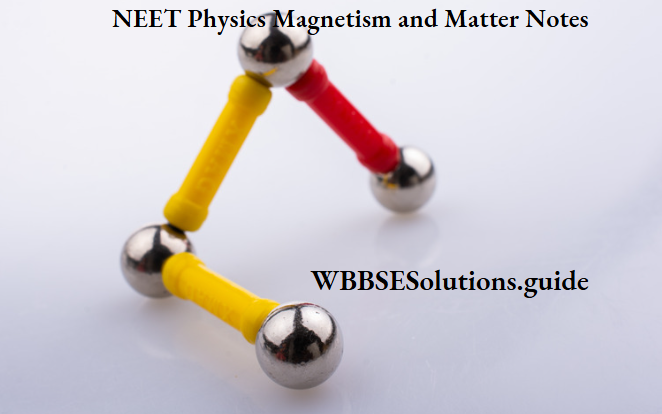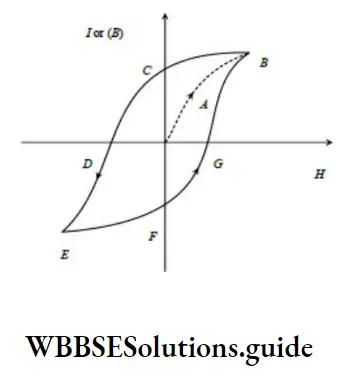NEET Physics Magnetism and Matter Notes
Magnetism and Matter
Coulomb’s law in magnetism is given by,
\(\mathrm{F}=\frac{\mu_0}{4 \pi} \frac{\mathrm{q}_{\mathrm{x}} \mathrm{q}_{\mathrm{E}_1}}{\mathrm{r}^2}\)Where is the permeability of free space, \(\mathrm{q}_{\mathrm{m}_1} \text { and } \mathrm{q}_{\mathrm{m}_2}\) are the pole strengths ‘r’ is the distance between two poles.
Read And Learn More: NEET Physics Notes
The magnetic moment of a magnet is given by,
\(\overrightarrow{\mathrm{m}}=\mathrm{q}_{\mathrm{m}}(2 \vec{\ell})\)Where 2l is the separation between two magnetic poles.
The magnetic moment of a current-carrying loop is given by,
\(\overrightarrow{\mathrm{m}}=\mathrm{I} \overrightarrow{\mathrm{A}}\)Best Notes for Magnetism and Matter NEET Preparation
If there are N turns, \(\overrightarrow{\mathrm{m}}=\mathrm{NIA}\)
The magnetic moment of a revolving electron is given by,
\(\begin{gathered}\mathrm{m}=\frac{\mathrm{eVT}}{2} \\
\mathrm{~m}=\frac{\mathrm{eVT}}{2} \times \frac{\mathrm{m}_{\mathrm{e}}}{\mathrm{m}_{\mathrm{e}}}=\frac{\mathrm{e}}{2 \mathrm{~m}_{\mathrm{e}}} \mathrm{L}
\end{gathered}\)
In vector form, \(\overrightarrow{\mathrm{m}}=-\left(\frac{\mathrm{e}}{2 \mathrm{~m}_{\ell}}\right) \overrightarrow{\mathrm{L}}\)
w.k.t., \(\mathrm{L}=\mathrm{n} \frac{\mathrm{h}}{2 \pi}\)
\(\mathrm{m}=\mathrm{n}\left(\frac{\mathrm{eh}}{4 \pi \mathrm{m}_{\mathrm{g}}}\right)\)Bohr Magneton (mB)
It is the magnetic dipole moment associated with an atom due to the orbital motion of an electron in the ground state of a hydrogen atom (n =1)
∴ \(\mathrm{m}_{\mathrm{B}}=\frac{\mathrm{eh}}{4 \pi \mathrm{m}_{\mathrm{e}}}=9.27 \times 10^{-24} \mathrm{Am}^2\)
The magnetic field on the axis of a bar magnet is given by:
\(\mathrm{B}_{\mathrm{xx}}=\frac{\mu_0}{4 \pi} \frac{2 \mathrm{mr}}{\left(\mathrm{r}^2-l^2\right)^2}\)If r > > l then
\(B_{2 x}=\frac{\mu_0}{4 \pi} \frac{2 m}{r^3} \text { or } \vec{B}_{2 x}=\frac{\mu_0}{4 \pi} \frac{2 \vec{m}}{r^3}\)
Magnetism and Matter NEET Important Questions with Solutions
Magnetic Field on the Equatorial Line of a Bar Magnet
\(\mathrm{B}_{\mathrm{*q}}=\frac{\mu_0 \mathrm{~m}}{4 \pi}\)If r > >l then, \(B_{e q}=\frac{\mu_0}{4 \pi} \frac{m}{r^3}\)
In vector form,
\(\vec{B}_{s q}=-\frac{\mu_0 \vec{m}}{4 \pi r^3}\)Magnetic field due to a bar magnet or magnetic dipole at a general point,
\(B_{\theta 4}=\frac{\mu_0}{4 \pi r^3} \sqrt{3 \cos ^2 \theta+1}\)Torque experienced by a bar magnet when it is placed in a uniform magnetic field is given by,
\(\begin{gathered}\vec{\tau}=\vec{m} \times \vec{B} \\
\tau=m B \sin \theta
\end{gathered}\)
Tricks to Solve Magnetism and Matter Problems for NEET
The potential energy of a bar magnet placed in a uniform magnetic field.
\(\begin{aligned}\mathrm{U} & =-\overrightarrow{\mathrm{m}} \cdot \overrightarrow{\mathrm{B}} \\
\mathrm{U} & =-\mathrm{mB} \cos \theta
\end{aligned}\)
Where is the angle between \(\overrightarrow{\mathrm{m}} \text { and } \overrightarrow{\mathrm{B}}\)
According to Gauss’ law in magnetism, the surface integral of magnetic field over a closed surface is always zero.
\(\text { i.e., } \oint_{\mathrm{s}} \overrightarrow{\mathrm{B}} \cdot \overrightarrow{\mathrm{ds}}=0\)Consequences of Gauss’ Law in Magnetism
Number of magnetic field lines leaving the surface is equal to number of magnetic field lines entering the surface.
Magnetic monopoles do not exist i.e., poles exist in unlike pairs of equal strengths.
The magnetic moment induced per unit volume of the substance is the intensity of magnetization.
\(I=\frac{M}{V} A m^{-1}\)Magnetic Susceptibility(χ):
\(\begin{gathered}I \propto H \\
I=\chi H \\
\text { or } \chi=\frac{I}{H}
\end{gathered}\)
Magnetic Permeability(μ):
\(\mu=\frac{B}{H}\)Relative magnetic permeability
\(\mu_r=\frac{\mu}{\mu_0}\)Relations amongst B, H, I, \(\chi \text { and } \mu\)
\((1) B=\mu H=B_0+\mu_0 I=\mu_0(H+I)(2) B=\mu_0 H(1+\chi)
(3) \mu=\mu_0(1+\chi)
(4) \mu_{,}=(1+\chi)\)
Magnetic Hysteresis Loop, B-H or I-H Curve

- B always lags behind H. This property is called magnetic hysteresis.
- The curve drawn between B and H is called B-H curve. It is a closed curve for one complete cycle of magnetization.
- Hysteresis loss per cycle per unit volume = area bounded by the hysteresis loop.
Magnetic Properties of Materials NEET MCQs with Answers
Types of Magnetic Materials
- Diamagnetic materials: They are weakly repelled by the bar magnet.
- Paramagnetic materials: They are weakly attracted by the bar magnet.
- Ferromagnetic materials: They are strongly attracted by the magnet
Curie’s Law and Curie Temperature
For a paramagnetic material, magnetic susceptibility is inversely proportional to absolute temperature.
\(\text { i.e., } \chi \propto \frac{1}{T} \quad \text { or } \chi=\frac{C}{T}\)For a ferromagnetic material
\(\chi=\frac{C}{\left(T-T_C\right)}\)where Tc is called curie temperature.
The temperature at or above which the ferromagnetic material behaves like a paramagnetic material is called Curie temperature.
Earth’s Magnetism
It is described in terms of three quantities, which are called magnetic elements of the earth.
These are:
Magnetic declination (000) at a place is the angle between the magnetic meridian and the geographic meridian.
Magnetic Inclination or dip at a place is defined as the angle , which is the direction of total intensity of earth’s magnetic field, B makes with a horizontal line in the magnetic meridian.
Earth’s Magnetism and Magnetic Field Lines NEET Notes
The horizontal component, H is the component of the total intensity of earth’s magnetic field (B) in the horizontal direction in magnetic meridian,
\(\begin{aligned}& \mathrm{H}=\mathrm{B} \cos \delta \\
& \mathrm{V}=\mathrm{B} \sin \delta
\end{aligned}\)
∴ \(\sqrt{H^2+V^2}=B\)
and \(\frac{V}{H}=\tan \delta\)
